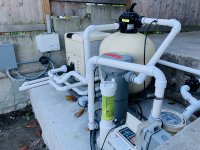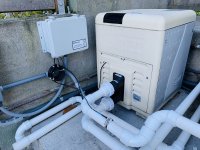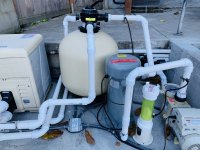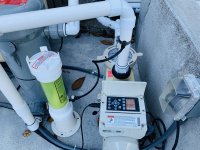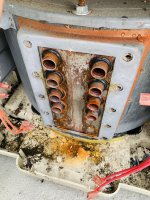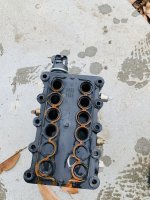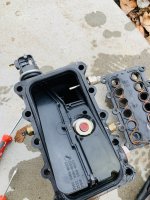No I don’t have check valves on the return side. I had check valves installed after the issue surfaced to resolve/mitigate this pump priming issue, but it didn’t help!Do you have any check valves? Occasional they will fail and cause very high restrictions.
Flow under 10 gpm in Filter mode vs 50 gpm in backwash
- Thread starter Joberg
- Start date
You are using an out of date browser. It may not display this or other websites correctly.
You should upgrade or use an alternative browser.
You should upgrade or use an alternative browser.
- May 3, 2007
- 17,176
- Pool Size
- 20000
- Surface
- Plaster
- Chlorine
- Salt Water Generator
- SWG Type
- Hayward Aqua Rite (T-15)
What is the pump RPM for these measurements?
What is the flow at full speed?
What are you using to measure GPM?
Can you post some pictures of your equipment?
The heater is a possibility as it has a built in bypass valve that might of failed.
What is the flow at full speed?
What are you using to measure GPM?
Can you post some pictures of your equipment?
The heater is a possibility as it has a built in bypass valve that might of failed.
2700What is the pump RPM for these measurements?
10 GPM in filter mode. In backwash, it reaches 50+ GPM (most likely limited by tubing size)What is the flow at full speed?
The pump displays itWhat are you using to measure GPM?
Can you post some pictures of your equipment?
See attached.
The heater is a possibility as it has a built in bypass valve that might of failed.
How can I troubleshoot / diagnose further if that’s the case?
Attachments
Last edited:
- May 3, 2007
- 17,176
- Pool Size
- 20000
- Surface
- Plaster
- Chlorine
- Salt Water Generator
- SWG Type
- Hayward Aqua Rite (T-15)
So are you saying that you get 10 GPM at both 2700 RPM and 3450 RPM?
Also, you mentioned that the equipment was moved. Did everything work ok before the move but not after the move?
Also, you mentioned that the equipment was moved. Did everything work ok before the move but not after the move?
It doesn’t go up to 3450 rpm, the panel alarms with a power-related error. Max I can push it up to is 2700 rpm.So are you saying that you get 10 GPM at both 2700 RPM and 3450 RPM?
Also, you mentioned that the equipment was moved. Did everything work ok before the move but not after the move?
That’s correct, the pump could prime properly the summer before the move. We winterized it, winter went by, we moved the equipment early spring, and then noticed it didn’t prime once reinstalled in new location.
The pool folks said it was due to the fact that the system was a few feet higher than ground level, and that I just have to never open the pump once it’s fully primed; they even installed check valves on the suction side to ensure the pump doesn’t lose it’s prime (but it didn’t work). I thought they were providing experts advice until I backwashed the system and saw the pump primed in less than 10 seconds (versus never).
Also note that the filter pressure valve doesn’t show any pressure. Could be defective, or another hint. I’ll replace it this weekend.
Last edited:
- May 3, 2007
- 17,176
- Pool Size
- 20000
- Surface
- Plaster
- Chlorine
- Salt Water Generator
- SWG Type
- Hayward Aqua Rite (T-15)
Given this is happening right after opening, I would suspect that there are still plugs in the returns. When the pump is running, have you checked the returns for any flow at all?
Also, what is the filter pressure at 2700 RPM?
Also, what is the filter pressure at 2700 RPM?
Last edited:
We only have one return jet to the pool, and I just checked, the pressure coming out is pretty strong already. Could it be that my return line is too small for the new piping? It did work fine before though but I never noticed the jet that strong (like it could hurt your back).Given this is happening right after opening, I would suspect that there are still plugs in the returns. When the pump is running, have you checked the returns for any flow at all?
Also, what is the filter pressure at 2700 RPM?
- May 3, 2007
- 17,176
- Pool Size
- 20000
- Surface
- Plaster
- Chlorine
- Salt Water Generator
- SWG Type
- Hayward Aqua Rite (T-15)
If the flow rate out of the return is strong, then the flow rate should be much higher than 10 GPM. Perhaps the pump is reporting an incorrect flow rate which is possible given the way the pump calculates flow rate from RPM and wattage.
Before the pad was moved, what did the pump report as flow rate?
What is the filter pressure?
What is the reported wattage of the pump?
Before the pad was moved, what did the pump report as flow rate?
What is the filter pressure?
What is the reported wattage of the pump?
If the flow rate out of the return is strong, then the flow rate should be much higher than 10 GPM. Perhaps the pump is reporting an incorrect flow rate which is possible given the way the pump calculates flow rate from RPM and wattage.
Before the pad was moved, what did the pump report as flow rate?
What is the filter pressure?
What is the reported wattage of the pump?
I read 50 gpm in backwash mode and that reading seems legit.
I don’t remember, I never checked since it was always easily primed.
the filter pressure is very low, doesn’t move much.
750watt
- May 3, 2007
- 17,176
- Pool Size
- 20000
- Surface
- Plaster
- Chlorine
- Salt Water Generator
- SWG Type
- Hayward Aqua Rite (T-15)
the filter pressure is very low, doesn’t move much.
Assuming the filter gauge is working, that paints a very different picture. If filter pressure is low, then the head loss from the filter forward is low and the restriction is most likely before the filter than after the filter.
Why was the UV device installed between the pump and filter? Have you check the internals for blockage?
There is a lot of contradictory information related to this issue.
I’m receiving the new Multiport Valve today, my hope is that the gasket is loose and pulls air from somewhere when in filter mode (backwash side of the gasket being tighter), that’s my theory. I’ll replace it tonight and share an update.Assuming the filter gauge is working, that paints a very different picture. If filter pressure is low, then the head loss from the filter forward is low and the restriction is most likely before the filter than after the filter.
Why was the UV device installed between the pump and filter? Have you check the internals for blockage?
There is a lot of contradictory information related to this issue.
I don’t know why the UV device was installed there. Is there a concern with that position/location? I haven’t looked for blockage, but in backwash mode, the UV device seems to operate well (50 gpm), it’s only in filter mode that it’s all slowed down. That’s why I think it’s either the multiport valve, or heater?
- May 3, 2007
- 17,176
- Pool Size
- 20000
- Surface
- Plaster
- Chlorine
- Salt Water Generator
- SWG Type
- Hayward Aqua Rite (T-15)
If the problem was the heater, the pressure would be higher than it is. The MPV could be the issue.
Having devices pre-filter is generally not a good idea because debris from the pump can cause blockages.
Having devices pre-filter is generally not a good idea because debris from the pump can cause blockages.
I changed the MPV, same problemIf the problem was the heater, the pressure would be higher than it is. The MPV could be the issue.
Having devices pre-filter is generally not a good idea because debris from the pump can cause blockages.
in filter mode:

May 21, 2021
in backwash mode:

May 21, 2021
Noise from heater in filter mode:

May 21, 2021
bubbles in the pool (in filter mode):

May 21, 2021
You can even hear the heater bubbling in the background.
The pressure valve was broken, I received/swapped in the new one, and now I can see the pressure reading properly:I changed the MPV, same problem. I attached videos of the system below, you can hear the noises from the heater… some kind of bubbling noise, air entering the system on the return?
in filter mode:

May 21, 2021
youtube.com
in backwash mode:

May 21, 2021
youtube.com
Noise from heater in filter mode:

May 21, 2021
youtube.com
bubbles in the pool (in filter mode):

May 21, 2021
youtube.com
You can even hear the heater bubbling in the background.

May 22, 2021
I’m doing a deep cleaning of the sand filter today.
- May 3, 2007
- 17,176
- Pool Size
- 20000
- Surface
- Plaster
- Chlorine
- Salt Water Generator
- SWG Type
- Hayward Aqua Rite (T-15)
Based upon your videos, the pump is not priming especially in pool mode and that is the reason the pump is displaying low flow rates because basically, there is no load on the motor. Initially, you said that the equipment is only a couple feet higher than the pool water but do you know exactly how much higher? Also, have you disabled the priming mode on the pump? The higher the pump is relative to the water level, the higher the RPM will need to be in order to prime the pump. With most VS pumps, they will ramp up to full speed during priming and then step down to a lower speed. Is this what is happening? I suspect the problem is really about priming and not about anything wrong with your plumbing.
If the pump is reporting high power, there could be an issue with the pump's impeller. Remove the motor/impeller and visual inspect for blockage and/or interference.
This should not happen. What is the exact alarm?It doesn’t go up to 3450 rpm, the panel alarms with a power-related error. Max I can push it up to is 2700 rpm.
If the pump is reporting high power, there could be an issue with the pump's impeller. Remove the motor/impeller and visual inspect for blockage and/or interference.
Based upon your videos, the pump is not priming especially in pool mode and that is the reason the pump is displaying low flow rates because basically, there is no load on the motor. Initially, you said that the equipment is only a couple feet higher than the pool water but do you know exactly how much higher? Also, have you disabled the priming mode on the pump? The higher the pump is relative to the water level, the higher the RPM will need to be in order to prime the pump. With most VS pumps, they will ramp up to full speed during priming and then step down to a lower speed. Is this what is happening? I suspect the problem is really about priming and not about anything wrong with your plumbing.
This should not happen. What is the exact alarm?
If the pump is reporting high power, there could be an issue with the pump's impeller. Remove the motor/impeller and visual inspect for blockage and/or interference.
I did a deep clean, and the problem persists but I think I finally root caused.
Let me provide a few more updates and I’ll answer the questions as well. I did pin it down to something wrong with my heater.
I unplugged the output of my heater to see if I could match the gpm I get in backwash mode, but in filter mode, and I can’t, see this video:
Why is the heater output not the same as in backwash mode? So I decided to unplug my heater input to see if that’s what is blocking the flow:
As you can see, the pump primed right away and I get between 40-50 gpm. So something is broken / blocking the flow in my heater?
How high is the pump from pool water level? 5 feet.
Have you disabled priming? Yes, otherwise the pump will turn off automatically after many priming attempts. If I enable priming then yes, it goes up to max speed configured for priming then in theory fallback to the desired selection. However I had to disable it since my pump doesn’t prime.
So I had max speed configured to 2700 rpm, I bumped it to 3400 rpm. Here’s what happens when I push the pump higher than 2700 rpm:
Gallon per minute goes up to about 20 gpm, and pressure goes from 10 psi to almost 30 psi. And the pump still doesn’t prime.
At this point though now I know something is wrong with my heater, something is blocking the flow in there. How can I debug further?
Last edited:
I did a deep clean, and the problem persists but I think I finally root caused.
Let me provide a few more updates and I’ll answer the questions as well. I did I pin it down to something wrong with my heater.
I unplugged the output of my heater to see if I could match the gpm I get in backwash mode, but in filter mode, and I can’t, see this video:
Why is the heater output not the same as in backwash mode? So I decided to unplug my heater input to see if that’s what I’d blocking the flow:
As you can see, the pump primed right away and I get between 40-50 gpm. So something is broken / blocking the flow in my heater?
How high is the pump from pool water level? 5 feet.
Have you disabled priming? Yes, otherwise the pump will turn off automatically after many priming attempts. If I enable priming then yes, it goes up to max speed configured for priming then in theory fallback to the desired selection. However I had to disable it since my pump doesn’t prime.
So I had max speed configured to 2700 rpm, I bumped it to 3400 rpm. Here’s what happens when I push the pump higher than 2700 rpm:
Gallon per minute goes up to about 20 gpm, and pressure goes from 10 psi to almost 30 psi. And the pump still doesn’t prime.
At this point though now I know something is wrong with my heater, something is blocking the flow in there. How can I debug further?
I disassembled the heater manifold to take a look at the bypass valve (see pictures attached). I opened up the manifold and fiddled with the bypass valve to see if it worked well:
The metal pipes coming out of the heater were pretty rusted, but seemed ok (see picture).
There’s another spring in there for the heat valve, also pretty tough / hard to squeeze.
So my hypothesis is either the rust indicates a problem with the heater / obstructing the flow, or the valves in the heater are just very tight, and slowing down the flow of water. Either way, it looks like I might as well replace the heater (it’s a 2016). What do you think? I’m afraid I might get the same issue with a brand new heater, with super tight valves. Should I get a heater without bypass valves?
Note that I just ordered a new bypass valve, I’ll test the spring manually, and if it’s less stiff, then I’ll open the manifold again, and swap the valve.
Attachments
Last edited:
- May 3, 2007
- 17,176
- Pool Size
- 20000
- Surface
- Plaster
- Chlorine
- Salt Water Generator
- SWG Type
- Hayward Aqua Rite (T-15)
The bypass valve is the one that would cause the extra head loss so you might try replacing that although that looks like it is working well. Are you sure the inlet and outlet ports were connected correctly?
2016 isn't very old. Mine has been running since 2005.
2016 isn't very old. Mine has been running since 2005.
The bypass valve is the one that would cause the extra head loss so you might try replacing that although that looks like it is working well. Are you sure the inlet and outlet ports were connected correctly?
2016 isn't very old. Mine has been running since 2005.
In the video above, I completely disconnected the outlet, and the flow is still reduced. So it’s either that valve that’s too tight, or the connection to the inlet? When I disconnect the inlet and turn the system on, water is flowing at the right rate. So it would somehow have to be something wrong with the manifold inlet or outlet? It looked fine to me (it’s really just large holes in a plastic manifold). If the valve is the cause for pressure drop then should I get a heater without bypass valve?
Thread Status
Hello , This thread has been inactive for over 60 days. New postings here are unlikely to be seen or responded to by other members. For better visibility, consider Starting A New Thread.


